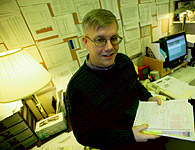Ask Me Another
Jim Fergerson – Bates’ own “Radar O’Reilly”
From the average age of the faculty (48) to the occupations held by the fewest Bates alumni vs. the most three in building and grounds maintenance vs. 4,346 in management numbers are Jim Fergerson’s business. He calls himself “the ultimate computer geek,” with a will to quantify that extends even to counting the mice he catches in his barn each winter. But it’s just this dedication to facts that makes Fergerson key to the College as director of Institutional Planning and Analysis, the office that gathers, interprets, and promulgates all manner of information about Bates. Bates found him in Lane Hall, where his office walls are papered thickly with graphs, memos, and magazine cartoons.

Jim Fergerson, director, Institutional Planning and Analysis
Q: What’s the most important function of your work?
Fergerson: Trying to know what people need to know before they know they need to know it. We try to see ourselves as Radar O’Reilly from M*A*S*H aware there are incoming issues well before anybody else can hear the helicopters.
Q: What do you think the most misunderstood aspect of your work is?
Fergerson: What does “institutional research” mean? Nobody really understands what we do. Essentially, what we try to do is digest a tremendous amount of data into information that people can use to make decisions about where Bates should be going.
Q: What are some of the challenging requests for information that you’ve had?
Fergerson: We are constantly being asked to do a complete racial/ethnic breakdown of our students back to the founding of the College.
And we are limited, of course, by what’s in the administrative database. Bates has only been computerized since about 1984 and not all records have been brought across the various computer conversions. But we often are asked to resurrect data what I call “data archaeology” and at times we delve into the library, the archives, old Trustee board records, for information. So we’ve been able to recreate tuition fees back to the founding of the College, enrollments back to the founding of the College.
Q Is it possible to define Bates through statistics?
Fergerson: A lot of people are trying to hold colleges much more accountable, and they often don’t see beyond pure facts. We’re a very quantitative office, but we understand that there’s much more out there to describe Bates the stories, the qualitative information. I’m very cautious about trying to boil the college down into one fact. Like, the U.S. News ranking is not the be-all and end-all of where the College is positioned.
Q How do people in your position feel about those rankings?
Fergerson: Generally, they are annoying, often inaccurate. They may not be asking the right questions. U.S. News tends to get more credibility because they have attempted to develop a methodology that at least approaches something that measures quality. But almost anybody in this profession would have considerable reservations about relying heavily on the information. Still, when you see the U.S News rankings, Princeton Review, data from federal sources, Bates seems to rank consistently highly by almost whatever measure.